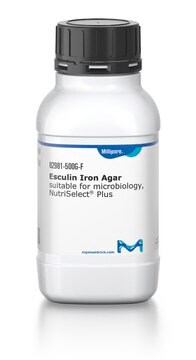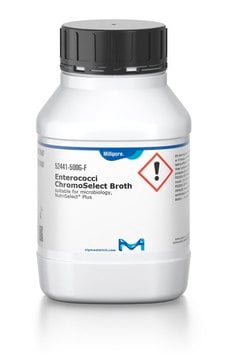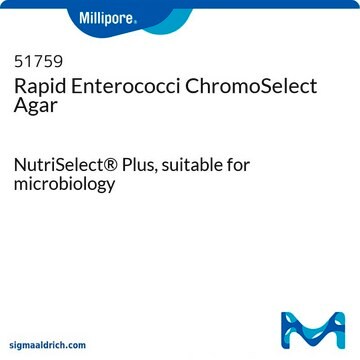48300
Bile esculin agar
suitable for microbiology, NutriSelect® Plus
Synonim(y):
Esculin Bile Agar
About This Item
Polecane produkty
agency
according to ISO 10273:2017
Poziom jakości
sterylność
non-sterile
linia produktu
BioChemika
Postać
powder
okres trwałości
limited shelf life, expiry date on the label
skład
agar, 15.0 g/L
esculin, 1 g/L
ferric citrate, 0.5 g/L
meat extract, 3 g/L
meat peptone, 5 g/L
ox-bile, 40 g/L
producent / nazwa handlowa
NutriSelect® Plus
metody
microbe id | specific enzyme detection: suitable
pH końcowe
6.6±0.2 (25 °C)
Zastosowanie
environmental
food and beverages
water monitoring
microbiology
przydatność
Streptococcus spp.
selective and differential for Enterococcus spp.
Zastosowanie
Uwaga dotycząca przygotowania
Przypis
The designations basic, plus, or prime are added to indicate the quality control level, from basic quality control to standard QC plus to prime for full regulatory compliance.
Informacje prawne
Kod klasy składowania
11 - Combustible Solids
Klasa zagrożenia wodnego (WGK)
WGK 3
Temperatura zapłonu (°F)
Not applicable
Temperatura zapłonu (°C)
Not applicable
Choose from one of the most recent versions:
Masz już ten produkt?
Dokumenty związane z niedawno zakupionymi produktami zostały zamieszczone w Bibliotece dokumentów.
Klienci oglądali również te produkty
Produkty
Microbiological assessment of bacteria found in spices, a potent source for food spoilage and pathogens.
Mikrobiologiczna ocena bakterii występujących w przyprawach, będących potencjalnym źródłem patogenów i powodujących psucie się żywności.
Nasz zespół naukowców ma doświadczenie we wszystkich obszarach badań, w tym w naukach przyrodniczych, materiałoznawstwie, syntezie chemicznej, chromatografii, analityce i wielu innych dziedzinach.
Skontaktuj się z zespołem ds. pomocy technicznej












